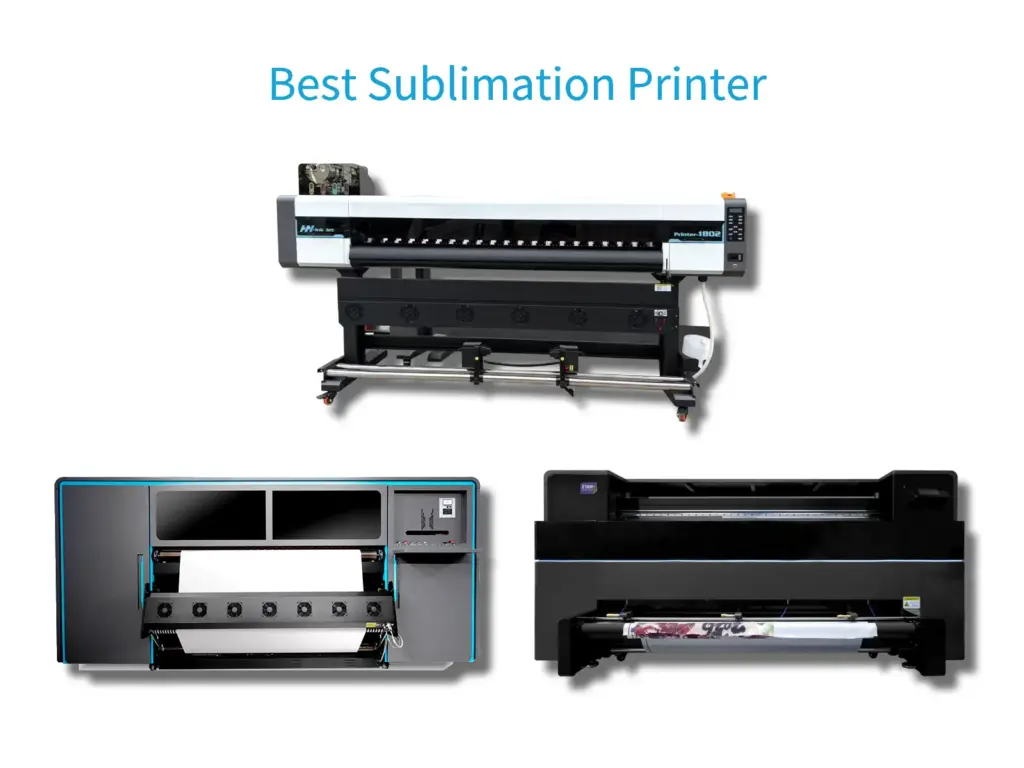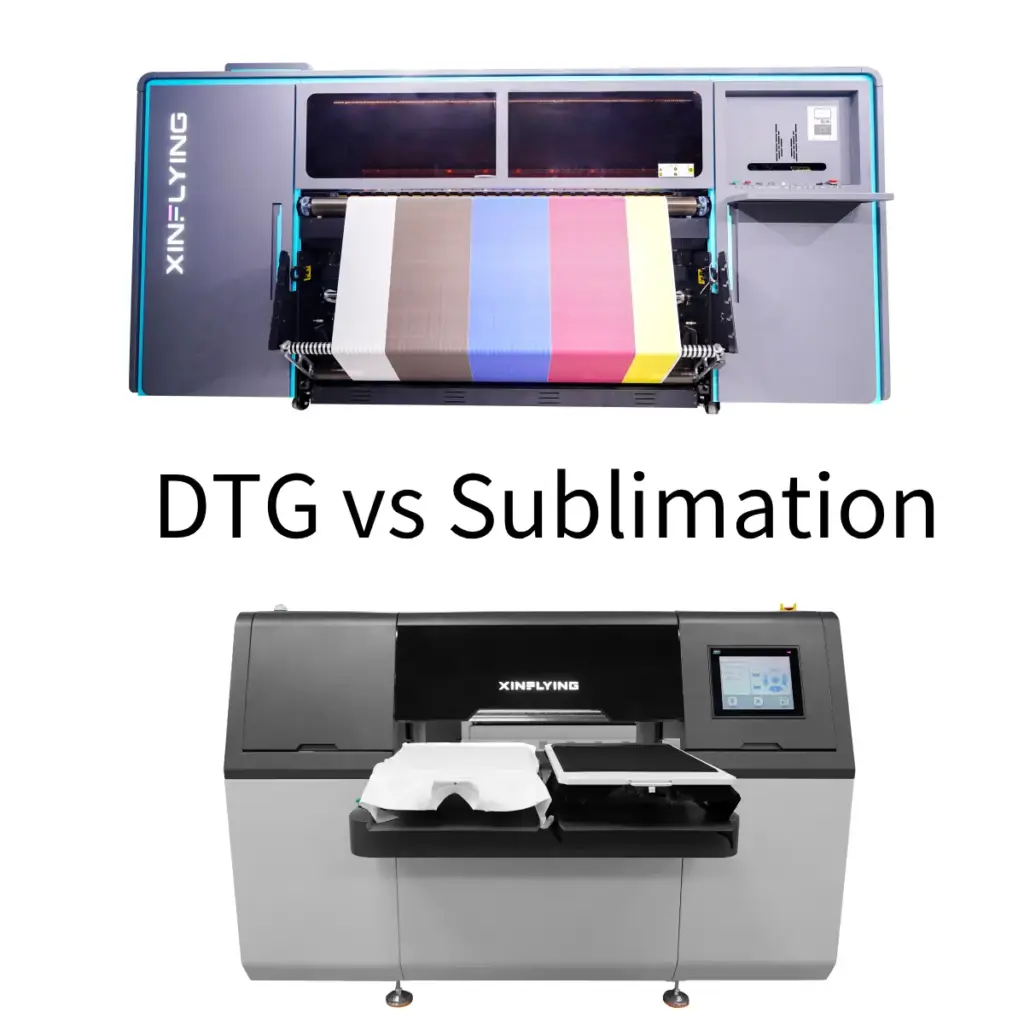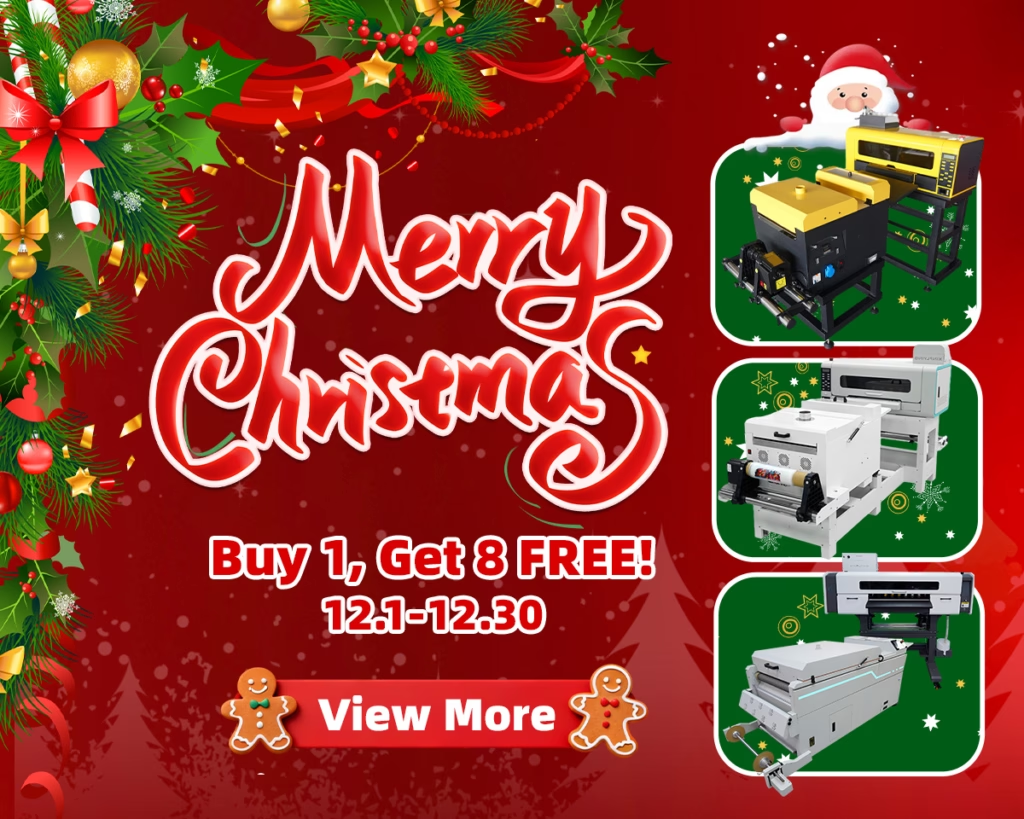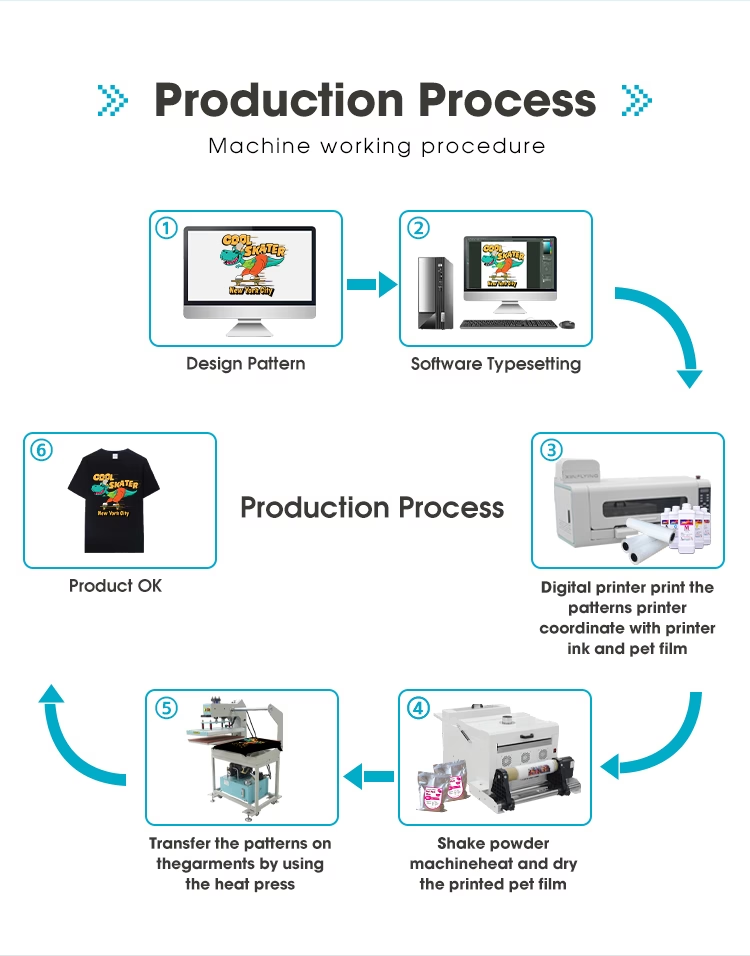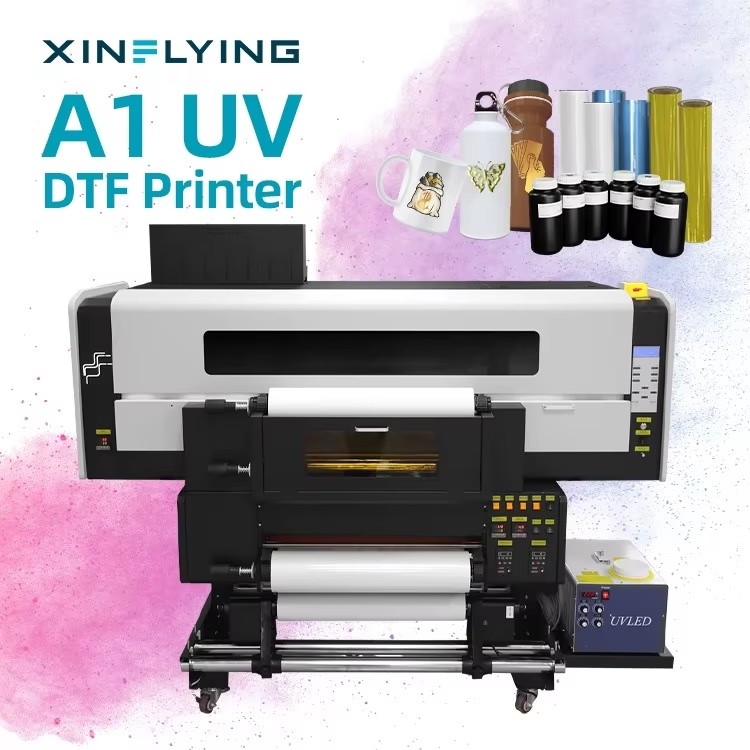La tecnología de impresión ha recorrido un largo camino, ofreciendo varios métodos para dar vida a las imágenes en diferentes superficies. Dos técnicas de impresión populares en la industria hoy en día son la impresión y la impresión de DTF UV.. Mientras que ambos métodos ofrecen resultados impresionantes, Tienen características distintas que los distinguen. En este articulo, profundizaremos en los detalles de cada método de impresión, comparar sus fortalezas y limitaciones, y proporcionar orientación para seleccionar el método de impresión adecuado para sus necesidades.
¿Qué es la impresión UV DTF??
Impresión UVDTF, Corto para la impresión de películas directas ultravioleta, es una tecnología de vanguardia que permite transferencias de imágenes de alta calidad en varios sustratos. A diferencia de los métodos de impresión tradicionales, Impresión UVDTF emplea ultravioleta (ultravioleta) tintas que se curan con luz UV para una durabilidad excepcional y colores vibrantes.
Cómo usar la impresora UV DTF?
Paso 1: Diseño en el software RIP
En primer lugar, Prepare la obra de arte con el software RIP en la computadora. Luego coloque el UV DTF una película en la plataforma de la impresora UV DTF.
Paso 2: Imprimir en una película
Llene previamente el cartucho con tinta CMYK, tinta blanca, y barniz para imprimir su diseño en la película UV DTF A.
Paso 3: Película B laminada
Coloque la película impresa en la máquina laminada para pegarla con la película B.
Paso 4: Coloque la película en los productos
Retire la película A del patrón y péguela en el artículo que desea imprimir.. Luego retira lentamente la película B., y tu producto está terminado.
Pros y contras de la impresión UV DTF

Ventajas de la impresión UV DTF
- Alta calidad de imagen y nitidez
La impresión UV DTF ofrece una calidad de imagen excepcional con detalles nítidos y colores vibrantes. Las tintas UV tienen una amplia gama de colores, permitiendo una reproducción precisa del color.
- Gama de colores anchos
La impresión UV DTF permite imprimir una amplia gama de colores en varios sustratos, resultando en diseños ricos y vibrantes.
- Tiempo de producción rápido
En comparación con los métodos de impresión tradicionales, La impresión UV DTF ofrece tiempos de producción más rápidos. Las tintas UV se secan casi al instante, Eliminando la necesidad de períodos de secado prolongados.
- Capacidad para imprimir en varios sustratos
La impresión UV DTF proporciona la flexibilidad para imprimir en una amplia gama de materiales, incluyendo telas, plástica, vaso, y más. Esta versatilidad lo convierte en una opción ideal para las empresas que buscan diversificar sus ofertas de productos..
Limitaciones de la impresión UV DTF
- Costo de tintas y equipos UV
La impresión UV DTF requiere tintas y equipos UV especializados, que puede ser más caro en comparación con los materiales de impresión tradicionales. Además, Las tintas UV pueden tener una vida útil más corta, Requerir reemplazos frecuentes.
- Flexibilidad limitada con ciertos materiales
Mientras que la impresión UV DTF se puede aplicar a varios sustratos, Algunos materiales pueden no ser adecuados debido a su textura o composición de la superficie. Es importante probar la impresión en diferentes materiales antes de comprometerse con la producción a gran escala..
- Requisitos de mantenimiento y mantenimiento
El equipo de impresión UV DTF requiere un mantenimiento y mantenimiento regulares para garantizar un rendimiento constante. Esto incluye limpiar los cabezales de la impresora y garantizar condiciones óptimas para el curado UV.
¿Qué es la impresión DTF??
impresión DTF, o Directa a la impresión de películas, es una técnica que implica imprimir diseños en una película que usa tintas especializadas, que luego se transfieren al sustrato deseado.
Cómo usar la impresora DTF?
Paso 1: Diseño en el software RIP
Similar a la impresión UV DTF, Diseñe la obra de arte utilizando software de diseño gráfico, Asegurar que se alcancen el diseño y la calidad de la imagen deseados.
Paso 2: Imprimir en la película PET
Inserte la película de mascotas en el impresora DTF bandejas y comenzar a imprimir. Luego, el patrón de diseño se transferirá a él..
Paso 3: Bond tinta con polvo
Con una máquina de agitación de polvo, el Polvo adhesivo DTF puede extenderse uniformemente en la película de mascotas y secar los gráficos.
Paso 4: Patrón de transferencia en textil
Coloque la película DTF PET en la parte superior del sustrato y transfiera el diseño con la máquina de prensa de calor.
Pros y contras de la impresión DTF
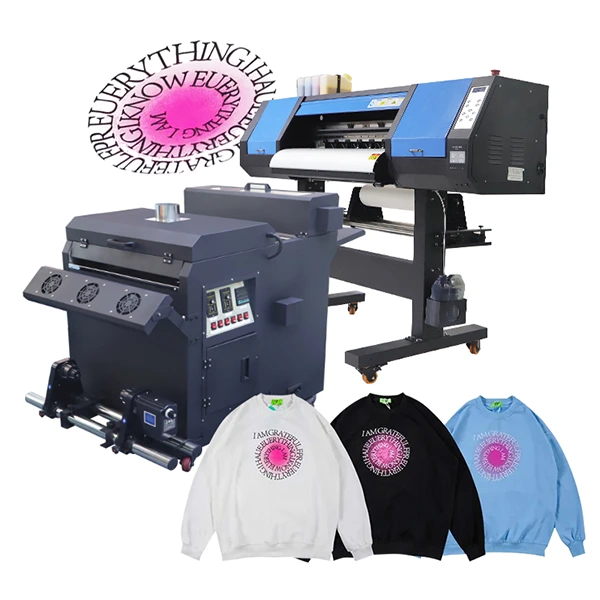
Ventajas de la impresión DTF
- Método de impresión rentable
La impresión DTF se considera rentable, Principalmente debido a su menor equipo y costos de tinta en comparación con la impresión UV DTF. Esto lo hace accesible para pequeñas empresas e individuos que buscan aventurarse en la industria de la impresión.
- Versatilidad en términos de sustratos compatibles
Como la impresión UV DTF, La impresión DTF permite imprimir en varios sustratos, incluyendo telas, cerámica, plástica, y más. Esta versatilidad expande la gama de productos que se pueden producir utilizando la impresión DTF.
- Capacidad para lograr colores vibrantes y detalles finos
La impresión DTF puede lograr colores vibrantes y vívidos, así como detalles finos, haciéndolo adecuado para diseños intrincados y obras de arte complejas.
- Fácil de usar y limpiar
Las impresoras DTF son fáciles de usar, Requerir una configuración y mantenimiento mínimos. Además, El proceso de limpieza es relativamente simple, permitiendo una operación más suave y un tiempo de inactividad reducido.
Limitaciones de la impresión DTF
- Gama de colores limitado en comparación con el dtf UV
Mientras que la impresión DTF puede lograr colores vibrantes, Su gama de colores puede ser más estrecha en comparación con el dtf UV, limitar la gama de tonos y tonos que se pueden reproducir.
- Tiempo de producción más largo
La impresión DTF puede requerir pasos adicionales para transferir el diseño al sustrato, que puede dar lugar a tiempos de producción más largos en comparación con la impresión UV DTF.
- Puede requerir pasos adicionales para ciertas telas
Ciertas telas pueden requerir procesos previos al tratamiento antes de imprimir con tintas DTF. Esto puede agregar complejidad y tiempo al proceso de impresión general.
UV DTF frente a DTF: Una comparación
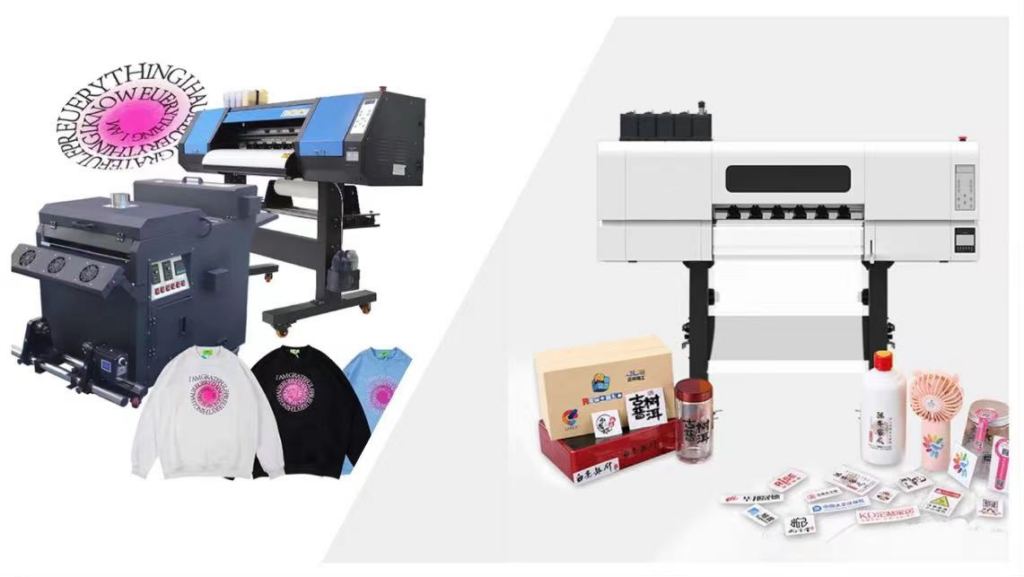
A. Comparación de calidad de impresión
Resolución y nitidez
La impresión UV DTF y DTF puede lograr impresiones de alta resolución con detalles nítidos. Sin embargo, La impresión UV DTF puede ofrecer resultados un poco más nítidos debido al proceso de curado UV, que mejora la permanencia de la tinta.
Precisión del color y vitalidad
La impresión UV DTF generalmente ofrece una gama de colores más amplia, Permitir una reproducción de color más precisa y diseños vibrantes. impresión DTF, mientras que capaz de colores vibrantes, Puede tener limitaciones para lograr ciertos tonos y tonos.
B. Tipos de sustratos
Opciones de tela
La impresión UV DTF y DTF se puede usar para imprimir en varios tipos de telas., incluyendo algodón, poliéster, y mezclas. Sin embargo, La impresión DTF puede requerir pasos adicionales o pretratamiento para ciertas telas para garantizar una adhesión de tinta óptima.
Impresión en superficies duras
Cuando se trata de imprimir en superficies duras como el vidrio, el plastico, o cerámica, La impresión UV DTF es la opción preferida. El proceso de curado UV garantiza una excelente adherencia a la tinta y durabilidad en estas superficies..
C. Velocidad de producción y eficiencia
La impresión UV DTF ofrece tiempos de producción más rápidos en comparación con la impresión DTF. El secado instantáneo de las tintas UV DTF elimina la necesidad de períodos de secado extendidos, Permitir un flujo de trabajo más eficiente.
D. Comparación de costos
La impresión UV DTF generalmente tiene mayores costos iniciales debido a las tintas y equipos UV especializados requeridos. impresión DTF, por otro lado, ofrece un punto de entrada más rentable para aquellos que comienzan su
empresas de impresión.
mi. Requisitos de mantenimiento y mantenimiento
Tanto los equipos de impresión UV DTF como DTF requieren mantenimiento regular y mantenimiento. Sin embargo, Las impresoras DTF UV pueden requerir limpiezas más frecuentes y reemplazos de tinta debido a la naturaleza de las tintas UV.
DTF vs UV DTF, Cual es mejor?
| Tipo | Impresión DTF | Impresión UVDTF |
| Tecnología | Imprime en una película que luego se presiona por calor sobre el material. | Combina la tecnología DTF con luz UV para curar instantáneamente la tinta. |
| Tinta | Utiliza CMYK+ tinta blanca, Impreso en una película de mascota transparente. | Usa tinta UV, Impreso en una película de mascota transparente. |
| Solicitud | Algodón, poliéster, mezclas de poli de algodón, cuero, nylon, y más. | Algodón, poliéster, mezclas de poli de algodón, cuero, nylon, el plastico, madera, metal, e incluso vidrio, y más. |
| Detalle | Muy alta calidad de imagen y detalle. | Alta calidad de imagen y detalle, Aunque el proceso UV puede afectarlo ligeramente. |
| Durabilidad | Altamente durable, pero podría no durar tanto como dtf UV. | Altamente durable, El proceso UV extiende la longevidad de la impresión. |
Tabla de comparación DTF vs UV DTF
Cuándo elegir la impresión UV DTF
La impresión UV DTF es una opción adecuada para empresas o personas que buscan impresiones de alta calidad con colores vibrantes y detalles nítidos. Es ideal para aquellos que priorizan los tiempos de producción más rápidos, necesitar impresión en superficies duras, y puede acomodar los costos iniciales más altos.
Cuándo elegir la impresión DTF
La impresión DTF es una opción rentable para aquellos que comienzan en la industria de la impresión. Ofrece versatilidad en términos de sustratos compatibles y es relativamente fácil de usar y mantener. Se recomienda la impresión DTF para aquellos que priorizan la eficiencia de los rentabilidades, versatilidad en los materiales de impresión, y simplicidad en funcionamiento.
Seleccionando el método de impresión correcto

Calidad de impresión deseada
Considere el nivel de nitidez de la imagen, precisión del color, y vitalidad requerida para sus impresiones. La impresión UV DTF sobresale en estas áreas, Mientras que la impresión DTF ofrece una opción más rentable con una calidad de impresión respetable.
Tipo de materiales para imprimir en
Tenga en cuenta la diversidad de sustratos que planea imprimir. Si anticipa la necesidad de imprimir en superficies duras o materiales que puedan requerir pretratamiento, La impresión UV DTF es la mejor opción.
Cantidades de producción y plazos
Si tiene plazos de producción estrictos o requisitos de impresión de alto volumen, El tiempo rápido de producción de UV DTF Printing puede ser más adecuado. Sin embargo, Si las cantidades de producción no son una preocupación principal, La impresión DTF ofrece una alternativa capaz.
Presupuesto disponible
Considere su presupuesto disponible para el equipo, tintas, y mantenimiento. La impresión UV DTF generalmente requiere una mayor inversión inicial, Mientras que la impresión DTF presenta un punto de entrada más rentable. También, Es importante elegir un fabricante confiable de impresoras de tela.
Conclusión
En conclusión, La impresión UV DTF y la impresión DTF son dos métodos distintos que ofrecen una calidad de imagen y versatilidad excepcionales.
La impresión UV DTF sobresale en términos de colores vibrantes, Detalles agudos, y la capacidad de imprimir en varios sustratos, Haciéndolo ideal para empresas con asignaciones de presupuesto más altas y necesidades de impresión específicas. impresión DTF, por otro lado, Proporciona un punto de entrada rentable para pequeñas empresas y personas que buscan versatilidad, sencillez, y facilidad de uso.
Por último, La elección entre la impresión UV DTF y la impresión DTF depende de factores como los requisitos de impresión, diversidad de sustratos, cantidades de producción, y presupuesto disponible. Considerando estos factores y comprender las fortalezas y limitaciones de cada método, Puede tomar una decisión informada y lograr resultados de impresión sobresalientes.

